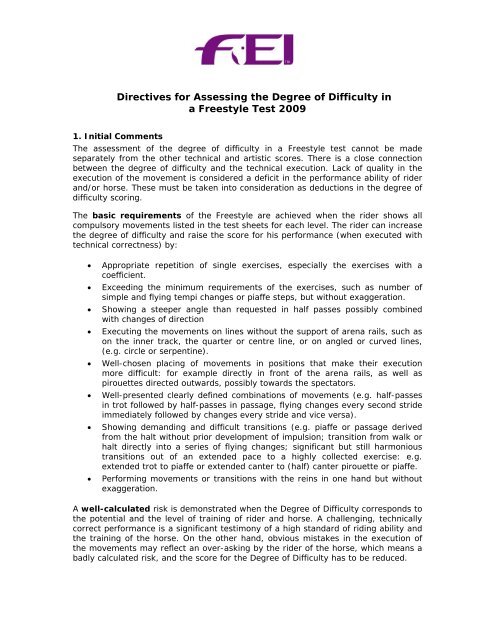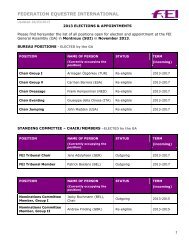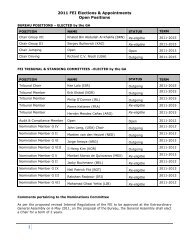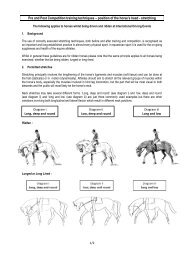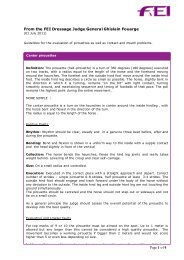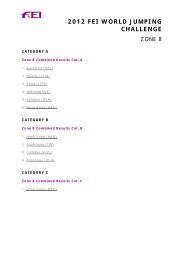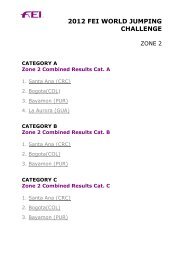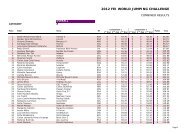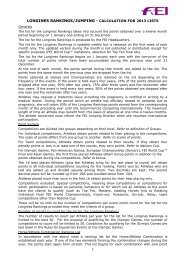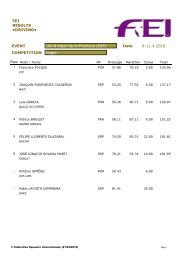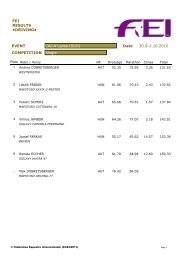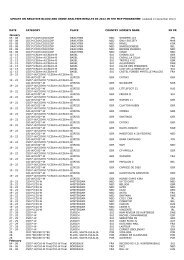Directives for Assessing the Degree of Difficulty in a Freestyle ... - FEI
Directives for Assessing the Degree of Difficulty in a Freestyle ... - FEI
Directives for Assessing the Degree of Difficulty in a Freestyle ... - FEI
Create successful ePaper yourself
Turn your PDF publications into a flip-book with our unique Google optimized e-Paper software.
<strong>Directives</strong> <strong>for</strong> <strong>Assess<strong>in</strong>g</strong> <strong>the</strong> <strong>Degree</strong> <strong>of</strong> <strong>Difficulty</strong> <strong>in</strong><br />
a <strong>Freestyle</strong> Test 2009<br />
1. Initial Comments<br />
The assessment <strong>of</strong> <strong>the</strong> degree <strong>of</strong> difficulty <strong>in</strong> a <strong>Freestyle</strong> test cannot be made<br />
separately from <strong>the</strong> o<strong>the</strong>r technical and artistic scores. There is a close connection<br />
between <strong>the</strong> degree <strong>of</strong> difficulty and <strong>the</strong> technical execution. Lack <strong>of</strong> quality <strong>in</strong> <strong>the</strong><br />
execution <strong>of</strong> <strong>the</strong> movement is considered a deficit <strong>in</strong> <strong>the</strong> per<strong>for</strong>mance ability <strong>of</strong> rider<br />
and/or horse. These must be taken <strong>in</strong>to consideration as deductions <strong>in</strong> <strong>the</strong> degree <strong>of</strong><br />
difficulty scor<strong>in</strong>g.<br />
The basic requirements <strong>of</strong> <strong>the</strong> <strong>Freestyle</strong> are achieved when <strong>the</strong> rider shows all<br />
compulsory movements listed <strong>in</strong> <strong>the</strong> test sheets <strong>for</strong> each level. The rider can <strong>in</strong>crease<br />
<strong>the</strong> degree <strong>of</strong> difficulty and raise <strong>the</strong> score <strong>for</strong> his per<strong>for</strong>mance (when executed with<br />
technical correctness) by:<br />
• Appropriate repetition <strong>of</strong> s<strong>in</strong>gle exercises, especially <strong>the</strong> exercises with a<br />
coefficient.<br />
• Exceed<strong>in</strong>g <strong>the</strong> m<strong>in</strong>imum requirements <strong>of</strong> <strong>the</strong> exercises, such as number <strong>of</strong><br />
simple and fly<strong>in</strong>g tempi changes or piaffe steps, but without exaggeration.<br />
• Show<strong>in</strong>g a steeper angle than requested <strong>in</strong> half passes possibly comb<strong>in</strong>ed<br />
with changes <strong>of</strong> direction<br />
• Execut<strong>in</strong>g <strong>the</strong> movements on l<strong>in</strong>es without <strong>the</strong> support <strong>of</strong> arena rails, such as<br />
on <strong>the</strong> <strong>in</strong>ner track, <strong>the</strong> quarter or centre l<strong>in</strong>e, or on angled or curved l<strong>in</strong>es,<br />
(e.g. circle or serpent<strong>in</strong>e).<br />
• Well-chosen plac<strong>in</strong>g <strong>of</strong> movements <strong>in</strong> positions that make <strong>the</strong>ir execution<br />
more difficult: <strong>for</strong> example directly <strong>in</strong> front <strong>of</strong> <strong>the</strong> arena rails, as well as<br />
pirouettes directed outwards, possibly towards <strong>the</strong> spectators.<br />
• Well-presented clearly def<strong>in</strong>ed comb<strong>in</strong>ations <strong>of</strong> movements (e.g. half-passes<br />
<strong>in</strong> trot followed by half-passes <strong>in</strong> passage, fly<strong>in</strong>g changes every second stride<br />
immediately followed by changes every stride and vice versa).<br />
• Show<strong>in</strong>g demand<strong>in</strong>g and difficult transitions (e.g. piaffe or passage derived<br />
from <strong>the</strong> halt without prior development <strong>of</strong> impulsion; transition from walk or<br />
halt directly <strong>in</strong>to a series <strong>of</strong> fly<strong>in</strong>g changes; significant but still harmonious<br />
transitions out <strong>of</strong> an extended pace to a highly collected exercise: e.g.<br />
extended trot to piaffe or extended canter to (half) canter pirouette or piaffe.<br />
• Per<strong>for</strong>m<strong>in</strong>g movements or transitions with <strong>the</strong> re<strong>in</strong>s <strong>in</strong> one hand but without<br />
exaggeration.<br />
A well-calculated risk is demonstrated when <strong>the</strong> <strong>Degree</strong> <strong>of</strong> <strong>Difficulty</strong> corresponds to<br />
<strong>the</strong> potential and <strong>the</strong> level <strong>of</strong> tra<strong>in</strong><strong>in</strong>g <strong>of</strong> rider and horse. A challeng<strong>in</strong>g, technically<br />
correct per<strong>for</strong>mance is a significant testimony <strong>of</strong> a high standard <strong>of</strong> rid<strong>in</strong>g ability and<br />
<strong>the</strong> tra<strong>in</strong><strong>in</strong>g <strong>of</strong> <strong>the</strong> horse. On <strong>the</strong> o<strong>the</strong>r hand, obvious mistakes <strong>in</strong> <strong>the</strong> execution <strong>of</strong><br />
<strong>the</strong> movements may reflect an over-ask<strong>in</strong>g by <strong>the</strong> rider <strong>of</strong> <strong>the</strong> horse, which means a<br />
badly calculated risk, and <strong>the</strong> score <strong>for</strong> <strong>the</strong> <strong>Degree</strong> <strong>of</strong> <strong>Difficulty</strong> has to be reduced.
If <strong>the</strong> classical dressage cannot be presented as stated <strong>in</strong> <strong>the</strong> rules, it is absolutely<br />
necessary to react by reduc<strong>in</strong>g <strong>the</strong> mark <strong>for</strong> <strong>the</strong> <strong>Degree</strong> <strong>of</strong> <strong>Difficulty</strong>.<br />
2. Guidel<strong>in</strong>es <strong>for</strong> Scor<strong>in</strong>g<br />
With special attention to <strong>the</strong> <strong>in</strong>itial comments and <strong>the</strong> clarifications <strong>in</strong> <strong>the</strong> Guidel<strong>in</strong>es<br />
<strong>for</strong> Judges, <strong>the</strong> recommended directives <strong>for</strong> po<strong>in</strong>ts awarded <strong>for</strong> degree <strong>of</strong> difficulty<br />
are as follows:<br />
• When only <strong>the</strong> m<strong>in</strong>imum requirements <strong>for</strong> <strong>the</strong> basis level are fulfilled,<br />
approximately 6.0.<br />
• When <strong>the</strong>re is a rise <strong>in</strong> <strong>the</strong> degree <strong>of</strong> difficulty accord<strong>in</strong>g to <strong>the</strong> level <strong>of</strong> <strong>the</strong><br />
respective standard tests m<strong>in</strong>imum <strong>of</strong> 7.0.<br />
• For each movement with <strong>in</strong>creased degree <strong>of</strong> difficulty (calculated risk) <strong>the</strong><br />
score should rise accord<strong>in</strong>gly.<br />
Additional Piaffe pirouettes and passage half passes are not considered as a higher<br />
degree <strong>of</strong> difficulty, although <strong>the</strong>y are to be rated positively <strong>in</strong> <strong>the</strong> choreography.


